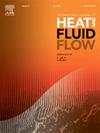Spatio-temporal temperature distribution and heat transfer analysis during subcooled nucleate pool boiling on plates
IF 2.6
3区 工程技术
Q2 ENGINEERING, MECHANICAL
International Journal of Heat and Fluid Flow
Pub Date : 2024-12-28
DOI:10.1016/j.ijheatfluidflow.2024.109737
引用次数: 0
Abstract
Nucleating bubbles contributes to improved heat transfer during the liquid–vapor phase transition and becomes beneficial in confined spaces where substantial energy transfer is necessary. The study is conducted to analyse the heat transfer mechanism and associated bubble behaviour during nucleate boiling at subcooled condition. The analysis is performed on horizontally oriented plates under ambient conditions. The temperature distribution over the plates at given heat flux is visualized using non-invasive IR thermal camera. The captured thermal images were initially analyzed to comprehend the impact of subcooling on different stages of the boiling process. It encompasses free convection from the surface, isolated heterogeneous nucleation, and the vertical agglomeration of detaching bubbles. The study gives an ideation to introspect the wall heat flux regime during subcooled pool boiling. Various phenomena associated with subcooled pool boiling, for instance, bubble ebullition, subcooling effect on heat transfer is discussed. The gradual shrinkage of bubble in the liquid pool is observed. The analysis of subcooled nucleate pool boiling on plates revealed intriguing insights into the spatio-temporal temperature variations, showcasing distinct patterns at different heat flux levels. Additionally, the study delved into the intricate wall heat flux partitioning among various boiling regimes, shedding light on the dynamics of bubble ebullition under subcooled conditions. An empirical correlation is suggested for predicting convective heat transfer coefficient for the subcooled pool boiling.
求助全文
约1分钟内获得全文
求助全文
来源期刊

International Journal of Heat and Fluid Flow
工程技术-工程:机械
CiteScore
5.00
自引率
7.70%
发文量
131
审稿时长
33 days
期刊介绍:
The International Journal of Heat and Fluid Flow welcomes high-quality original contributions on experimental, computational, and physical aspects of convective heat transfer and fluid dynamics relevant to engineering or the environment, including multiphase and microscale flows.
Papers reporting the application of these disciplines to design and development, with emphasis on new technological fields, are also welcomed. Some of these new fields include microscale electronic and mechanical systems; medical and biological systems; and thermal and flow control in both the internal and external environment.
 求助内容:
求助内容: 应助结果提醒方式:
应助结果提醒方式:


